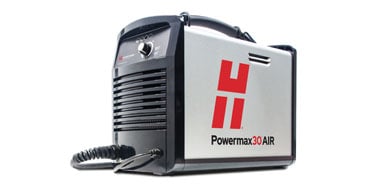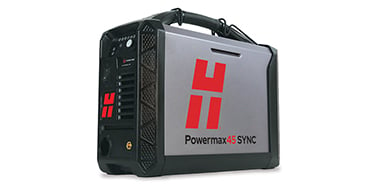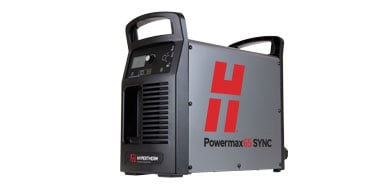Portable plasma cutter for the worker on the job site

Metal cutting using thermal systems, like oxyfuel (aka flame cutting) or plasma, have become the method of choice for a wide array of applications. It is very likely that you would find one of these systems being used by all types of welders, fabricators, machinists, or ironworkers, from metalwork artists and DIY hobbyists to autobody repair technicians, machine shop operators, workers on job shops, and engineers on the factory floor. For heavy industrial applications, software-driven CNC plasma machines can be equipped for plasma metal cutting However, many industries need portable, hand-held metal cutting options. The two most common methods of portable cutting are plasma and oxyfuel.
Why is portability important?
In many metal fabrication jobs, it’s vital that the plasma cutter be portable so it can be moved to the area where the work is done rather than taking the metal to where the equipment is. Furthermore, the plasma cutting is lightweight, and its small size enables it to be easily and safely transported by one or two people. Plasma cutter designs have improved tremendously over time to become highly portable and more powerful. For instance, a MAX100 (popular, 100A plasma cutter from the 1990s) and the current Powermax65 SYNC (65A plasma cutter) both cut 1 ¼” at 5 inches per minute (IPM), but the newer model is 85% smaller and 85% lighter.
Another reason portability is important is the type of power that is available at the location where the cutting or gouging is done. Plasma cutters that are designed to operate off of single and three-phase power or have a wide operating voltage range are most portable and flexible. Systems that also have a wide voltage tolerance range and are designed to protect themselves when there are large swings in power output from perhaps an older engine-driven generator are very important because such variation could adversely affect the plasma cutter's performance as well as reliability.
Let’s take a quick look at the differences between the oxyfuel and plasma techniques.
How oxyfuel cutting works
Oxyfuel cutting creates a reaction between pure oxygen and steel to make iron oxide. It is often described as rapid, controlled rusting. Preheat flames are used to raise the surface or edge temperature of the steel to approximately 962° C (1800° F, bright red color). Pure oxygen is then directed toward the heated area via a fine, high-pressure stream controlled via regulators. The steel is oxidized and blown away to form a cavity while the preheat and oxygen stream travel at constant speed to produce an unbroken, continuous cut. The type of fuel gases used can affect various parameters of the cutting process. Acetylene, propane, propylene, and natural gas are most often used in conjunction with oxygen. The decision for which fuel gas to use depends upon the cutting application and relative costs, heat output requirement, and oxygen consumption.
How plasma cutting works

A plasma cutter or plasma cutting system uses a plasma arc to transfer energy to a conductive material. The plasma arc is typically formed by forcing a gas such as nitrogen, oxygen, argon — or even air — through a narrow nozzle. The nozzle is one piece of a consumable stack or cartridge which includes an electrode. An electric current produced by an external power supply adds sufficient energy to the gas flow through the electrode to ionize it, turning it into a plasma arc. This is why the process is often called plasma “arc” cutting. The plasma arc cuts the workpiece by first melting it, and then blowing away the molten metal.
The starting method for creating the plasma arc varies- some systems use a high-frequency method while some use a pilot arc. A pilot arc plasma cutter is generally viewed as safer. Pilot arc is typically used for hand-held, portable, air plasma systems, while high frequency is generally used for mechanized, heavy-duty systems.
For this post, we’ll focus on air plasma metal cutting machines and how they are used out in the field.
The advantages of plasma torches over oxyfuel are well known
Plasma cutting equipment is known for precise cuts, cutting capacity, speed and productivity, lower operating costs, and versatility. Plasma tools can cut any electrically conductive metal, including mild steel, stainless steel, and aluminum, and it can handle rusted, painted, and expanded metal. The plasma cutting process creates a clean cut with minimal slag and typically delivers smooth cuts with a narrower kerf than those produced by an oxyfuel torch. Saving process time, the metal to be cut doesn’t need to be preheated and faster speeds can be achieved on thinner sheet metals, with minimal or no metal distortion. Also, plasma typically outperforms oxyfuel torches when cutting stacked metals.
Because air plasma cutters do not require the use of flammable gasses, they also provide safety advantages over other cutting systems, like oxyfuel cutting tools which commonly use highly unstable and flammable acetylene as its fuel source.
Out in the field, however, which metal cutting tools are most practical as jobs may take workers to remote locations, like in a mine or on a ship? HVAC contractors may be working on ladders, climbing into awkward spaces. Of course, manual tools are always an option: old-school metal snips, shears, and hacksaws can handle some lightweight metal cutting jobs, but the work is slow, and the cuts are typically crude. Portability is a key criterion. Early on, oxyfuel cutters were thought to be more practical for offsite work since they don’t require electrical power or an air compressor, as is the case with plasma cutters, and operate at almost any site.
However, technological advances have now made plasma cutting a standard, portable option. The new generation of plasma cutters has been designed for portability: they are lightweight but deliver enough power to cut through almost any metal. Now, having a lightweight and easy-to-set-up tool for beginners, portable plasma cutters are an essential tool for anyone working with metal. Also, the need for electrical power is not an issue on most job sites as engine-driven generators are commonly available.

Hypertherm plasma cutters offer best-in-class portability

The Hypertherm Powermax® family of portable plasma cutting machines are great examples of lightweight tools that pack a powerful punch for a variety of applications. The 30-amp plasma cutter Powermax30 ® AIR takes portability a step further as it features a built-in air compressor which means workers only need a power source and the tool itself. Essentially, this dual voltage and portable 13.5 kg (30 lb.) plasma cutter can be operated anywhere and boasts the same advantages as its larger amperage siblings – superior cut quality, fast cutting speeds, low operating costs, a great multi-year warranty, and ability to cut a variety of metal types and cutting thicknesses.
Hypertherm also offers different types of consumables that can help with portability. The Powermax SYNC single-piece cartridge consumable replaces a 5-piece stack, which makes it easier to bring into the field and not worry about putting the consumables together correctly. Hypertherm also offers HyAccess consumables that are 3 inches long, allowing users to cut in hard-to-reach places.





